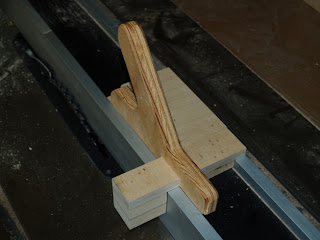American Woodworker put out a video, about marketing shop classes. I found the video to be rather bothering and somewhat off-putting in that it was too full of hyperbole, bragging and bravado. I have posted it here as I am curious what my readers think about the program. Is this the direction that marketing woodworking programs should proceed? I certainly agree that woodworking has an important role to play in our children's education. But should the idea of woodshop be to set up assembly lines, making things to sell for program profits? Does it have a few more important things to offer? What is the most appropriate means of determining program success?
 As far as lifelong learning goes, working with wood is the best. Following my table saw injury, I decided to make a new, safer push stick for ripping thin strips of wood, or for resawing thicker stock for making box sides. You can see the results in the images at left and below. A block of wood rides between the two sides of the fence, giving the push stick a secure position as it pushes the wood safely through the cut. The grip is simply made from one of my old push sticks, so it is a grip very comfortable to my hand, and keeps my hand a safe distance from the blade.
As far as lifelong learning goes, working with wood is the best. Following my table saw injury, I decided to make a new, safer push stick for ripping thin strips of wood, or for resawing thicker stock for making box sides. You can see the results in the images at left and below. A block of wood rides between the two sides of the fence, giving the push stick a secure position as it pushes the wood safely through the cut. The grip is simply made from one of my old push sticks, so it is a grip very comfortable to my hand, and keeps my hand a safe distance from the blade.Make, fix and create...

"...it was too full of hyperbole, bragging and bravado."
ReplyDeleteI think that sums up my opinion of the video pretty well.
I felt uncomfortable watching the video. I made it about 90 seconds in.
ReplyDeleteI think that the notion of lifelong learning has a constant almost spiritual aspect to it. It needs to be nurtured. That is something we're trying to achieve at Fort Worden - not easy.
That said I think there are communities and individuals who will respond to a direct (if somewhat testosterone fueled) approach. If that helps them on the path to craftsmanship - it is the first step.
We need to restore and reconnect communities of craftsman with their communities and I think it is vital to future of the crafts and trades. Ensuring that consumers will turn to local options before seeking imported goods. (Oops may be starting a different thread.) If this approach help build those communities then we should embrace this approach.
I too am uncomfortable with the philosophy behind "The Unstoppable Shop". From a woodwork perspective, the student loses the sense of ownership over the project they are working on which is a huge part of the learning experience. The program seems to turn students into assembly line workers with rigidly defined tasks rather than craftsmen who think for themselves (and can, therefore, learn by themselves).
ReplyDeleteFrom a public school perspective, the idea that a course should fund itself seems antithetical to the idea of equality of opportunity. It seems to be introducing an unhealthy type of competition into the public school system.
I am fortunate enough that my program is fully funded, although budgets are always tight. This year, in my 8-12 high school of 520 students, we had 135 students in woodwork, another 80 in metalwork, 28 in drafting/CAD, 40 in auto mechanics, and 110 grade eights in a 50 hour mosaic course. That's 2.25 teachers. There is no lack of interest in Industrial Education in my school.
However, if my funding dried up, I might have to look into "The Unstoppable Shop" as a better than nothing alternative.
Nick S
Northern British Columbia
Nick, I don't think tight budgets are such a bad deal. They encourage thrift. The also encourage resourcefulness, watchfulness, stewardship.
ReplyDelete"Off-putting" would be much too polite a word for that video, to those of us who see working in the shop as something closer to the spiritual than the commercial. And by the way, you can add cooking to the list of activities. My younger son learned from his mother, and then has learned enough in school and on his own that he would see what he does in a "fine dining" restaurant as another example of what you talk about.
ReplyDeleteMario
Mario, cooking should definitely have been mentioned. Today at our UU church, Crescent Dragonwagon talked about what you could learn from beans and cornbread if you were paying attention. There is philosophy and a path toward a better life if you are paying attention. Crescent, a long time friend (36 years), has a new book out about Beans... already in its second printing.
ReplyDeleteDoug
All I can say is oh dear oh dear and echoe what the others have said. Also I have found that if you employ people from such a system you have to do a lot of "unlearning " before you can let them work safely and independatly .
ReplyDeleteI love Crescent's concept of learning from beans and cornbread. And I will check out her book.
ReplyDeleteMario